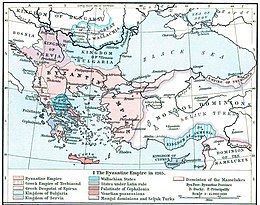Siege of Berat (1280–1281)
| Siege of Berat | |||||||
|---|---|---|---|---|---|---|---|
| Part of the Byzantine–Latin Wars | |||||||
 Map of the Byzantine Empire and the surrounding states in 1265. |
|||||||
|
|||||||
| Belligerents | |||||||
|
|
|
||||||
| Commanders and leaders | |||||||
|
|
|
||||||
| Strength | |||||||
| Unknown | 8,000 men | ||||||
The Siege of Berat in Albania by the forces of the Angevin Kingdom of Sicily against the Byzantine garrison of the city took place in 1280–1281. Berat was a strategically important fortress, whose possession would allow the Angevins access to the heartlands of the Byzantine Empire. A Byzantine relief force arrived in spring 1281, and managed to ambush and capture the Angevin commander, Hugo de Sully. Thereupon, the Angevin army panicked and fled, suffering heavy losses in killed and wounded as it was attacked by the Byzantines. This defeat ended the threat of a land invasion of the Byzantine Empire, and along with the Sicilian Vespers marked the end of the Western threat to reconquer Byzantium.
Ever since the Emperor Michael VIII Palaiologos (r. 1259–1282) recovered Constantinople from the Latin Empire in 1261, the restored Byzantine Empire faced the threat of a Latin crusade to reclaim the city. The antagonistic Greek Despotate of Epirus and the Latin states of southern Greece, fearful of the Byzantine resurgence, sought aid from the Kingdom of Sicily, first under Manfred of Sicily (r. 1258–1266), and after 1266 under the ambitious Charles of Anjou (r. 1266–1285), who quickly established himself as Byzantium's chief antagonist. Countering the Angevin ruler's alliances and efforts to conquer Byzantium would occupy the remainder of Michael VIII's reign.
In 1258, the Sicilians took possession of the island of Corfu and the Albanian coast, from Dyrrhachium to Valona and Buthrotum and as far inland as Berat. This gave Manfred a strategically vital beachhead in the Balkans, controlling the western terminus of the great Via Egnatia, the main overland route to Constantinople. Already in the 11th and 12th centuries, the same area had been the target of the Normans of southern Italy in their attacks on the Empire. After overthrowing Manfred, in the Treaty of Viterbo (1267) Charles secured his recognition as Manfred's heir. In 1272, the Latin notables who had held the fortresses of Valona, Kanina, and Berat for Manfred surrendered them to Charles, and soon afterwards Charles's troops took Dyrrhachium too. Having secured the support of many Albanian chieftains, Charles proclaimed the establishment of the Kingdom of Albania in the same year.
...
Wikipedia
